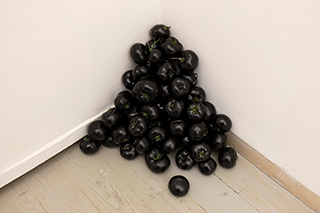
Binta Diaw, Nero sangue 2020-2022
pomodori vetrificati, pittura acrilica, inchiostro xerox trasferito su cotone| vetrified tomatoes, acrylic paint, transfer of xerox ink on cotton
Courtesy dell’artista | Courtesy of the artist
Photo © Amedeo Benestante
At the center of Nero Sangue resides the Black Body, immersed in the logic of exploitation and control in which labor in tomato fields evokes practices of modern slavery. As James Baldwin states, the historical production of the Black Body is imbued with pain and terror, it is the fanonian expérience vécue du Noir, an experience lived in a state of chronic uncertainty, which sees the image of one’s own body denied and crystallized by the white gaze. This context is framed by colonialism and fascism that dehumanize the Black Body by portraying it immersed in vegetation, from behind, sitting, surrounded by cattle. Images from which the will to show a supposed physical, mental and technological superiority of the “Italian race” emerges. The blood thus becomes a central element of the narrative: the shed and honored blood of the “fallen”, those who die to defend the race and to give Italy that aguishly coveted place in the sun through the misappropriation of land and resources, the creation of concentration camps, the use of torture and chemical weapons. Blood, however, is also what unites and gives citizenship to black children born in colony, ius sanguinis, the right to blood. Blood is, today, the exclusive element, the one that prevents thousands of people born/arrived and raised in Italy from being citizens of this country. And blood is also the blood shed by the Black Body, bent in the fields picking tomatoes, bodies that die for lack of drinking water, for lack of health care, burned in fires caused by dangerous situations in dilapidated housing, or for illegal working conditions. Black, Body, Red, Blood. The Black Body has historically shown us “fugitivity” (Moten and Harney) as a weapon of resistance, as a means to break chains which are not only physical. The body is used as a means to carve out their resistance. Escape, fight, poisoning, secretly spoken and deliberately carved languages, self-inflicted mutilations: the strategies of black resistance pass from the body that from organic matter becomes a political body on which to inscribe indelible messages. A body under threat of constant loss, and yet, a body that exposes itself and resists. This is the legacy of our ancestors. The right to have a Body.
– Angelica Pesarini